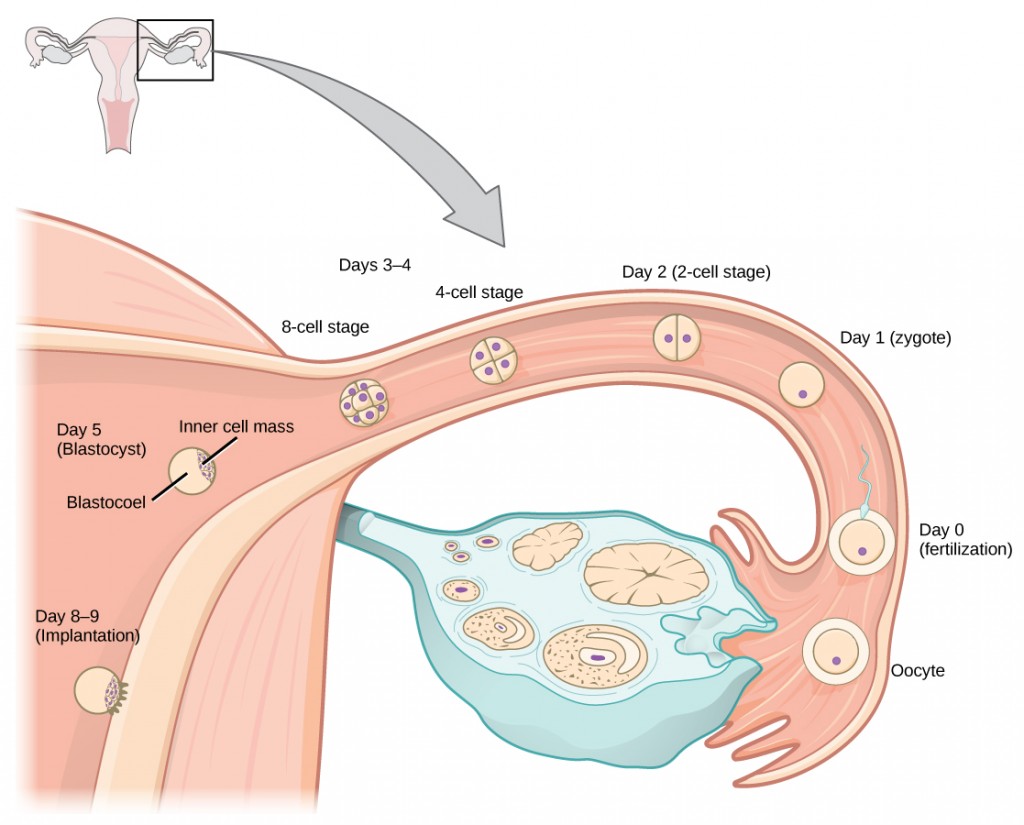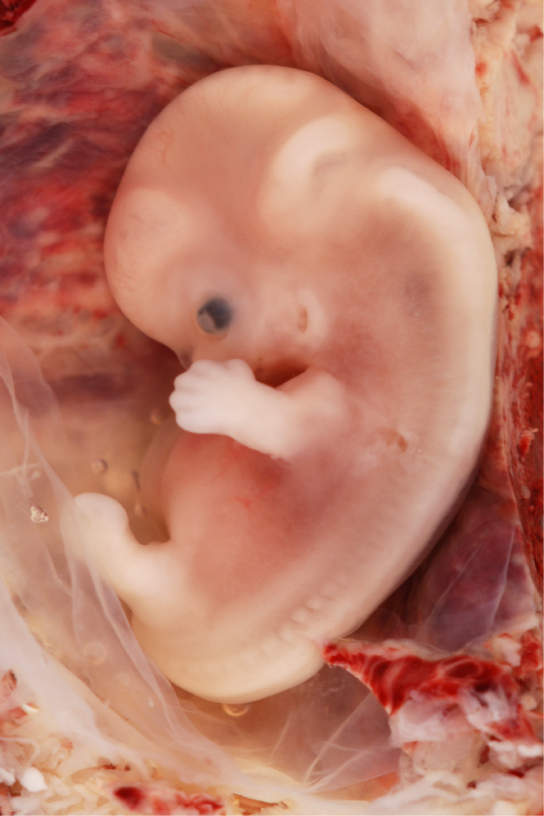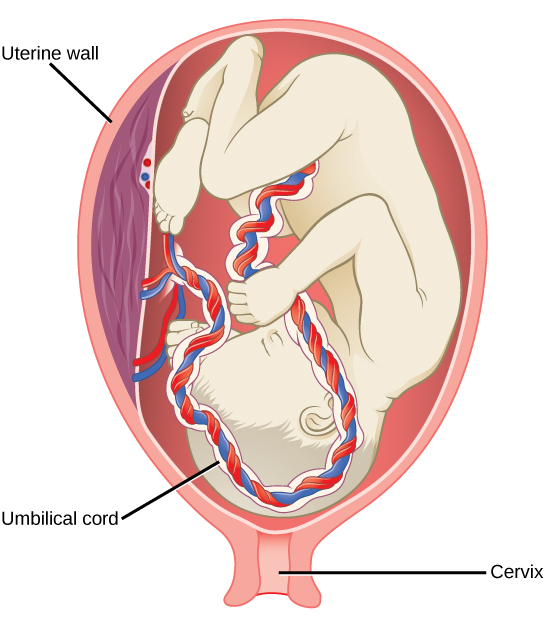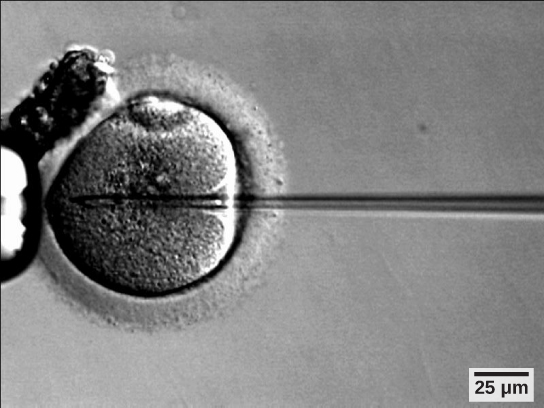Pregnancy Biology of Heredity Review Answers Chapter 4
Chapter 24. Animal Reproduction and Evolution
24.v. Homo Pregnancy and Birth
Learning Objectives
Past the end of this department, you volition be able to:
- Explicate fetal development during the 3 trimesters of gestation
- Describe labor and delivery
- Compare the efficacy and elapsing of various types of contraception
- Discuss causes of infertility and the therapeutic options available
Pregnancy begins with the fertilization of an egg and continues through to the birth of the individual. The length of time of gestation varies among animals, but is very similar amongst the peachy apes: human gestation is 266 days, while chimpanzee gestation is 237 days, a gorilla'southward is 257 days, and orangutan gestation is 260 days long. The fox has a 57-solar day gestation. Dogs and cats have similar gestations averaging lx days. The longest gestation for a land mammal is an African elephant at 640 days. The longest gestations amongst marine mammals are the beluga and sperm whales at 460 days.
Human Gestation
Twenty-iv hours earlier fertilization, the egg has finished meiosis and becomes a mature oocyte. When fertilized (at conception) the egg becomes known every bit a zygote. The zygote travels through the oviduct to the uterus (Figure 24.18). The developing embryo must implant into the wall of the uterus inside vii days, or it will deteriorate and die. The outer layers of the zygote (blastocyst) grow into the endometrium past digesting the endometrial cells, and wound healing of the endometrium closes up the blastocyst into the tissue. Another layer of the blastocyst, the chorion, begins releasing a hormone called human beta chorionic gonadotropin (β-HCG) which makes its way to the corpus luteum and keeps that structure active. This ensures adequate levels of progesterone that will maintain the endometrium of the uterus for the support of the developing embryo. Pregnancy tests decide the level of β -HCG in urine or serum. If the hormone is present, the exam is positive.

The gestation period is divided into three equal periods or trimesters. During the start ii to 4 weeks of the first trimester, diet and waste matter are handled by the endometrial lining through diffusion. As the trimester progresses, the outer layer of the embryo begins to merge with the endometrium, and the placenta forms. This organ takes over the nutrient and waste matter requirements of the embryo and fetus, with the mother's blood passing nutrients to the placenta and removing waste from it. Chemicals from the fetus, such equally bilirubin, are processed past the mother's liver for elimination. Some of the female parent'due south immunoglobulins will laissez passer through the placenta, providing passive immunity confronting some potential infections.
Internal organs and torso structures begin to develop during the first trimester. By five weeks, limb buds, eyes, the heart, and liver accept been basically formed. By eight weeks, the term fetus applies, and the body is essentially formed, every bit shown in Figure 24.xix. The private is about five centimeters (two inches) in length and many of the organs, such as the lungs and liver, are not yet performance. Exposure to any toxins is especially unsafe during the start trimester, as all of the body's organs and structures are going through initial development. Anything that affects that development can have a severe effect on the fetus' survival.

During the 2d trimester, the fetus grows to about 30 cm (12 inches), as shown in Figure 24.20. It becomes active and the mother normally feels the first movements. All organs and structures continue to develop. The placenta has taken over the functions of nutrition and waste and the production of estrogen and progesterone from the corpus luteum, which has degenerated. The placenta will go along performance up through the delivery of the baby.

During the third trimester, the fetus grows to 3 to 4 kg (six ½ -8 ½ lbs.) and almost 50 cm (19-20 inches) long, as illustrated in Figure 24.21. This is the catamenia of the most rapid growth during the pregnancy. Organ development continues to birth (and some systems, such as the nervous organization and liver, continue to develop after nascency). The mother will be at her virtually uncomfortable during this trimester. She may urinate oftentimes due to force per unit area on the bladder from the fetus. There may as well be intestinal blockage and circulatory issues, especially in her legs. Clots may form in her legs due to pressure from the fetus on returning veins equally they enter the abdominal cavity.

Concept in Activity

Visit this site to meet the stages of human being fetal development.
Labor and Birth
Labor is the physical efforts of expulsion of the fetus and the placenta from the uterus during nascence (parturition). Toward the end of the tertiary trimester, estrogen causes receptors on the uterine wall to develop and bind the hormone oxytocin. At this fourth dimension, the babe reorients, facing forward and downwardly with the back or crown of the head engaging the neck (uterine opening). This causes the cervix to stretch and nerve impulses are sent to the hypothalamus, which signals for the release of oxytocin from the posterior pituitary. The oxytocin causes the smoothen muscle in the uterine wall to contract. At the aforementioned fourth dimension, the placenta releases prostaglandins into the uterus, increasing the contractions. A positive feedback relay occurs betwixt the uterus, hypothalamus, and the posterior pituitary to assure an adequate supply of oxytocin. As more shine muscle cells are recruited, the contractions increase in intensity and strength.
There are three stages to labor. During stage one, the cervix thins and dilates. This is necessary for the baby and placenta to be expelled during nativity. The cervix volition eventually dilate to almost x cm. During stage two, the baby is expelled from the uterus. The uterus contracts and the female parent pushes as she compresses her abdominal muscles to aid the delivery. The last phase is the passage of the placenta afterwards the baby has been born and the organ has completely disengaged from the uterine wall. If labor should cease before stage ii is reached, synthetic oxytocin, known every bit Pitocin, can be administered to restart and maintain labor.
An culling to labor and delivery is the surgical delivery of the baby through a process chosen a Caesarian department. This is major abdominal surgery and can lead to post-surgical complications for the mother, simply in some cases information technology may be the only manner to safely deliver the baby.
The mother's mammary glands become through changes during the third trimester to prepare for lactation and breastfeeding. When the baby begins suckling at the breast, signals are sent to the hypothalamus causing the release of prolactin from the anterior pituitary. Prolactin causes the mammary glands to produce milk. Oxytocin is also released, promoting the release of the milk. The milk contains nutrients for the baby'south development and growth as well as immunoglobulins to protect the kid from bacterial and viral infections.
Contraception and Birth Control
The prevention of a pregnancy comes nether the terms contraception or birth control. Strictly speaking, contraception refers to preventing the sperm and egg from joining. Both terms are, even so, frequently used interchangeably.
| Method | Examples | Failure Rate in Typical Use Over 12 Months |
|---|---|---|
| Barrier | male condom, female condom, sponge, cervical cap, diaphragm, spermicides | xv to 24% |
| Hormonal | oral, patch, vaginal ring | 8% |
| injection | three% | |
| implant | less than ane% | |
| Other | natural family planning | 12 to 25% |
| withdrawal | 27% | |
| sterilization | less than one% |
Table 24.3 lists common methods of contraception. The failure rates listed are not the platonic rates that could be realized, but the typical rates that occur. A failure rate is the number of pregnancies resulting from the method's use over a twelve-month menstruum. Barrier methods, such every bit condoms, cervical caps, and diaphragms, block sperm from entering the uterus, preventing fertilization. Spermicides are chemicals that are placed in the vagina that kill sperm. Sponges, which are saturated with spermicides, are placed in the vagina at the cervical opening. Combinations of spermicidal chemicals and barrier methods achieve lower failure rates than do the methods when used separately.
Nearly a quarter of the couples using barrier methods, natural family planning, or withdrawal can await a failure of the method. Natural family planning is based on the monitoring of the menstrual cycle and having intercourse only during times when the egg is not available. A woman'south trunk temperature may rise a degree Celsius at ovulation and the cervical mucus may increase in volume and become more pliable. These changes give a general indication of when intercourse is more or less probable to result in fertilization. Withdrawal involves the removal of the penis from the vagina during intercourse, before ejaculation occurs. This is a risky method with a loftier failure rate due to the possible presence of sperm in the bulbourethral gland's secretion, which may enter the vagina prior to removing the penis.
Hormonal methods use synthetic progesterone (sometimes in combination with estrogen), to inhibit the hypothalamus from releasing FSH or LH, and thus forestall an egg from beingness bachelor for fertilization. The method of administering the hormone affects failure rate. The most reliable method, with a failure rate of less than 1 percent, is the implantation of the hormone under the skin. The aforementioned rate can exist accomplished through the sterilization procedures of vasectomy in the homo or of tubal ligation in the woman, or by using an intrauterine device (IUD). IUDs are inserted into the uterus and establish an inflammatory condition that prevents fertilized eggs from implanting into the uterine wall.
Compliance with the contraceptive method is a strong contributor to the success or failure rate of any detail method. The only method that is completely constructive at preventing conception is abstinence. The option of contraceptive method depends on the goals of the woman or couple. Tubal ligation and vasectomy are considered permanent prevention, while other methods are reversible and provide brusque-term contraception.
Termination of an existing pregnancy can be spontaneous or voluntary. Spontaneous termination is a miscarriage and ordinarily occurs very early in the pregnancy, ordinarily within the first few weeks. This occurs when the fetus cannot develop properly and the gestation is naturally terminated. Voluntary termination of a pregnancy is an abortion. Laws regulating abortion vary betwixt states and tend to view fetal viability every bit the criteria for assuasive or preventing the procedure.
Infertility
Infertility is the inability to conceive a kid or acquit a child to birth. About 75 pct of causes of infertility can be identified; these include diseases, such as sexually transmitted diseases that can cause scarring of the reproductive tubes in either men or women, or developmental problems frequently related to aberrant hormone levels in 1 of the individuals. Inadequate diet, especially starvation, tin can delay menstruation. Stress can also lead to infertility. Curt-term stress can affect hormone levels, while long-term stress can delay puberty and cause less frequent menstrual cycles. Other factors that affect fertility include toxins (such as cadmium), tobacco smoking, marijuana use, gonadal injuries, and aging.
If infertility is identified, several assisted reproductive technologies (Fine art) are available to aid conception. A common type of ART is in vitro fertilization (IVF) where an egg and sperm are combined exterior the torso and then placed in the uterus. Eggs are obtained from the woman later extensive hormonal treatments that set mature eggs for fertilization and prepare the uterus for implantation of the fertilized egg. Sperm are obtained from the man and they are combined with the eggs and supported through several cell divisions to ensure viability of the zygotes. When the embryos have reached the 8-cell phase, one or more than is implanted into the woman's uterus. If fertilization is not accomplished by simple IVF, a procedure that injects the sperm into an egg can exist used. This is chosen intracytoplasmic sperm injection (ICSI) and is shown in Figure 24.22. IVF procedures produce a surplus of fertilized eggs and embryos that can be frozen and stored for future use. The procedures tin can also consequence in multiple births.

Summary
Human pregnancy begins with fertilization of an egg and proceeds through the 3 trimesters of gestation. The labor procedure has three stages (contractions, delivery of the fetus, expulsion of the placenta), each propelled by hormones. The first trimester lays downward the basic structures of the body, including the limb buds, heart, eyes, and the liver. The second trimester continues the development of all of the organs and systems. The 3rd trimester exhibits the greatest growth of the fetus and culminates in labor and delivery. Prevention of a pregnancy can be accomplished through a diversity of methods including barriers, hormones, or other means. Assisted reproductive technologies may help individuals who take infertility issues.
Exercises
- Food and waste material requirements for the developing fetus are handled during the kickoff few weeks by:
- the placenta
- diffusion through the endometrium
- the chorion
- the blastocyst
- Progesterone is made during the third trimester by the:
- placenta
- endometrial lining
- chorion
- corpus luteum
- Which contraceptive method is 100 percent constructive at preventing pregnancy?
- condom
- oral hormonal methods
- sterilization
- abstinence
- Which type of brusque term contraceptive method is generally more effective than others?
- bulwark
- horomonal
- natural family unit planning
- withdrawal
- Which hormone is primarily responsible for the contractions during labor?
- oxytocin
- estrogen
- β -HCG
- progesterone
- Major organs begin to develop during which part of human gestation?
- fertilization
- kickoff trimester
- second trimester
- third trimester
- Describe the major developments during each trimester of human gestation.
- Describe the stages of labor.
Answers
- B
- A
- D
- B
- A
- B
- The first trimester lays down the basic structures of the torso, including the limb buds, center, eyes, and the liver. The 2d trimester continues the development of all of the organs and systems established during the first trimester. The placenta takes over the product of estrogen and loftier levels of progesterone and handles the nutrient and waste requirements of the fetus. The third trimester exhibits the greatest growth of the fetus, culminating in labor and delivery.
- Stage one of labor results in the thinning of the neck and the dilation of the cervical opening. Stage two delivers the infant, and stage three delivers the placenta.
Glossary
contraception (also, birth control)
various means used to prevent pregnancy
gestation
length of time for fetal evolution to nascence
human being beta chorionic gonadotropin ( β -HCG)
hormone produced past the chorion of the zygote that helps to maintain the corpus luteum and elevated levels of progesterone
infertility
inability to conceive, carry, and deliver children
placenta
organ that supports the improvidence of nutrients and waste between the female parent'due south and fetus' blood
Source: https://opentextbc.ca/biology/chapter/24-5-human-pregnancy-and-birth/
0 Response to "Pregnancy Biology of Heredity Review Answers Chapter 4"
Post a Comment